HOUND ARCHONS
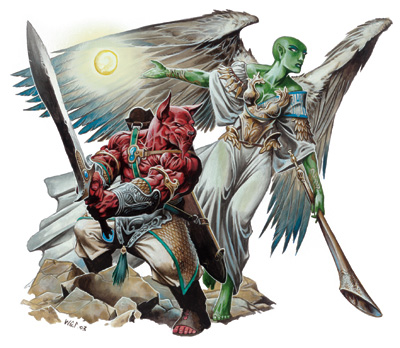
Hound archons look like well-muscled humans with canine heads. They seek to defend the innocent and the helpless against evil.
Their broad shoulders and meaty fists mark hound archons as able combatants. Likewise, their strong legs indicate that fleeing enemies won't get very far.
Archons are celestials from the plane of Celestia. They have charged themselves with the protection of the plane, and also consider themselves guardians of all who are innocent or free of evil. They are the natural enemies of fiends (creatures of the lower planes), particularly demons.
Hound archons always fight with a will. They prefer to attack with their natural weapons but occasionally use greatswords.
Archons never attack without provocation (though their overwhelming lawful goodness often makes them easily provoked). They avoid harming other good creatures if they can, using nondamaging spells or weapon attacks that deal nonlethal damage if possible. An angry archon can be vengeance itself, however, no matter what the foe's alignment is.
Archons generally prefer to meet a foe head-on if it is prudent to do so, but if outmatched, they do what they can to even the odds (usually by employing hit-and run tactics or standing off and engaging a foe with magic before moving into melee).
HOUND ARCHON RACIAL TRAITS
-
+4 Strength, +2 Constitution, +2 Wisdom, +2 Charisma.
-
Medium size.
-
A hound archon's base land speed is 40 feet.
-
Racial Hit Dice: A hound archon begins with six levels of outsider, which provide 6d8 Hit Dice, a base attack bonus of +6, and base saving throw bonuses of Fort +5, Ref +5, and Will +5.
-
Racial Skills: A hound archon's outsider levels give it skill points equal to 9 × (8 + Int modifier). Its class skills are Concentration, Hide, Jump, Listen, Move Silently, Sense Motive, Spot, and Survival. While in canine form, a hound archon gains a +4 circumstance bonus on Hide and Survival checks.
-
Racial Feats: A hound archon's outsider levels give it three feats.
-
+9 natural armor bonus.
-
Natural Weapons: Bite (1d8) and slam (1d4).
-
A hound archon's natural weapons, as well as any weapons it wields, are treated as good-aligned and lawful-aligned for the purpose of overcoming damage reduction.
-
Archon Traits: Darkvision 60 ft., low-light vision, aura of menace (Will DC 15 + character's Cha modifier), immunity to electricity and petrification, +4 racial bonus on saves against poison, magic circle against evil, teleport, tongues.
-
Spell-Like Abilities: At will - aid, continual flame, detect evil, message. Caster level 6th.
-
Change Shape (Su): A hound archon can assume any canine form of Small to Large size. While in canine form, the hound archon loses its bite, slam, and greatsword attacks, but gains the bite attack of the form it chooses. For the purposes of this ability, canines include any doglike or wolflike animal of the animal type.
-
Damage reduction 10/evil.
-
Scent.
-
Spell resistance equal to 16 + class levels.
-
Automatic Languages: Celestial. Bonus Languages: Common, Draconic, Infernal.
-
Favored class: Ranger.
-
Level adjustment +5.
AZERS
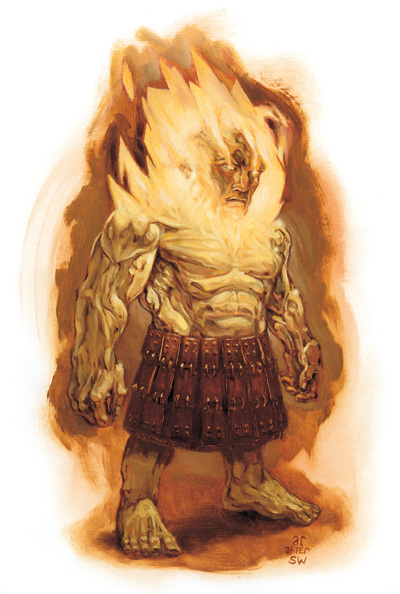
Azers are dwarflike beings native to the Elemental Plane of Fire. They wear kilts of brass, bronze, or copper.
Azers maintain a tightly regimented society in which every member has a specific place. The state always takes precedence over the individual. Azer nobles are prodigiously strong and wield absolute power. Azers dwell within bronze fortresses on their home plane, only rarely visiting other planes to gather gems. They hate efreet, with whom they wage an eternal war for territory and slaves.
Azers use broad-headed spears or well-crafted hammers in combat. When unarmed, they attempt to grapple foes. Although unfriendly and taciturn, azers rarely provoke a fight except to relieve a foe of gems, which they love. If threatened, they fight to the death, but they see the value of taking prisoners themselves.
Rare among their well-ordered kind, a few azers leave behind the absolute rule of their kin. These explorers tend to be fierce warriors, quick to take offense.
AZER RACIAL TRAITS
-
+2 Strength, +2 Dexterity, +2 Constitution, +2 Intelligence, +2 Wisdom, -2 Charisma.
-
Medium size.
-
An azer's base land speed is 30 feet.
-
Darkvision: Azers can see in the dark up to 60 feet.
-
Racial Hit Dice: An azer begins with two levels of outsider, which provide 2d8 Hit Dice, a base attack bonus of +2, and base saving throw bonuses of Fort +3, Ref +3, and Will +3.
-
Racial Skills: An azer's outsider levels give it skill points equal to 5 x (8 + Int modifier). Its class skills are Appraise, Climb, Craft, Hide, Jump, Listen, Search, and Spot.
-
Racial Feats: An azer's outsider levels give it one feat.
-
+6 natural armor bonus.
-
Heat (Ex): An azer's body is intensely hot, so its unarmed attacks deal an extra 1 point of fire damage. Its metallic weapons also conduct this heat.
-
Fire Subtype: Immunity to fire, vulnerability to cold.
-
Spell resistance equal to 13 + class levels.
-
Automatic Languages: Common, Ignan. Bonus Languages: Abyssal, Aquan, Auran, Celestial, Infernal, Terran.
-
Favored Class: Fighter.
-
Level adjustment +4.
BUGBEARS

The biggest and strongest of the goblinoids, bugbears are more aggressive than their smaller relatives. They live by hunting any creature weaker than themselves.
The bugbear's nose is the cause of its name, though the creature is not related to bears. Its hide and sharp claws also resemble those of bears. A bugbear's hands are far more dexterous than a bear's paws, however, and its claws are too small to make effective weapons.
Bugbears prefer to ambush opponents whenever possible. When hunting, they normally send scouts ahead of the main group that, if they spy prey, return to report and bring up reinforcements. Bugbear attacks are coordinated, and their tactics are sound if not brilliant.
Bugbears prefer to dwell in temperate, mountainous regions with many caves, living in small tribal units. A single bugbear, usually the biggest and meanest, leads each tribe. A tribe has as many young as it has adults. Children do not join the adults in the hunt, but they will fight to protect themselves or their lairs.
Bugbears have only two genuine goals in life: food and treasure. Prey and intruders are considered a valuable source of both. These extremely greedy creatures prize anything shiny, including arms and armor. They never miss an opportunity to increase their hoards through theft, plunder, and ambush. On rare occasions they parley with other beings if they believe something can be gained, but they are not skilled negotiators, losing their patience quickly if such encounters run overlong. They are sometimes found commanding goblins and hobgoblins, whom they bully mercilessly.
Bugbears survive primarily by hunting, and they eat whatever they can bring down. Any creature is a legitimate source of food, including monsters and even their own smaller kin. When game is scarce, bugbears turn to raiding and ambush to fill their stewpots.
Most bugbears revere a deity named Hruggek, who delights in ambushes followed by furious combat. Bugbear clerics worship Hruggek and can choose any two of the following domains: Chaos, Evil, Trickery, and War.
BUGBEAR RACIAL TRAITS
-
+4 Strength, +2 Dexterity, +2 Constitution, -2 Charisma.
-
Medium size.
-
A bugbear's base land speed is 30 feet.
-
Darkvision out to 60 feet.
-
Racial Hit Dice: A bugbear begins with three levels of humanoid, which provide 3d8 Hit Dice, a base attack bonus of +2, and base saving throw bonuses of Fort +1, Ref +3, and Will +1.
-
Racial Skills: A bugbear's humanoid levels give it skill points equal to 6 x (2 + Int modifier). Its class skills are Climb, Hide, Listen, Move Silently, Search, and Spot.
-
Racial Feats: A bugbear's humanoid levels give it two feats.
-
+3 natural armor bonus.
-
+4 racial bonus on Move Silently checks.
-
Scent.
-
Automatic Languages: Common, Goblin. Bonus Languages: Draconic, Elven, Giant, Gnoll, Orc.
-
Favored Class: Rogue.
-
Level adjustment +1.
CENTAURS
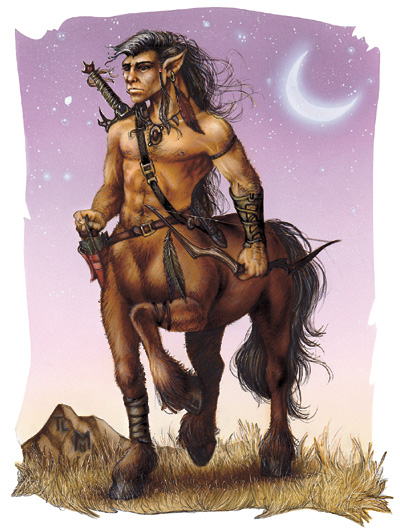
Centaurs are woodland beings who shun the company of strangers. They are deadly archers and even more fearsome in melee. Although generally mild-tempered, centaurs are always armed. Their favorite melee weapon is the longsword. When scouting or hunting, they carry composite longbows. A centaur employing a lance deals double damage when it charges, just as a rider on a mount does.
Centaurs usually don't provoke a fight. Their normal response to aggression is swift retreat, perhaps after launching a few arrows to discourage pursuit. Against creatures powerful enough to pose danger to the tribe, they appear to use this same tactic, except that about half of the "retreating" centaurs will circle around to lie in ambush or attack the foe from the rear.
Among their own kind, centaurs are sociable creatures, but they have been known to become rowdy, boorish, and aggressive when under the influence of alcohol.
Solitary centaurs are usually out hunting or scouting. Companies and troops are usually hunting or scouting in force. Most of the members of a centaur tribe remain near their lair. Most of the centaurs in the tribal lair are female; while the males are out hunting and scouting, the females lead and administer the tribe. A third of a tribe's population is young.
The typical centaur lair is located deep within a forest. It consists of a large hidden glade and pastures, with a good supply of running water. Depending on the climate, the lair may contain huts or lean-tos to shelter individual families. Hearths for cooking and warmth are in an open area, away from the trees.
Centaurs are skilled in horticulture and may cultivate useful plants near their lair. In dangerous, monster-infested areas they plant thick barriers of thorn bushes around their lair, dig pits, and set snares. Centaurs survive through a mixture of hunting, foraging, fishing, agriculture, and trade. Though they shun dealings with humans, centaurs do trade with elves, especially for food and wine. The elves are paid from the tribe's treasury, which consists of the booty of slain monsters.
The size of a centaur tribe's territory varies with its population and the nature of the area it inhabits. Centaurs do not object to sharing territory with elves. The attitude of a centaur toward a stranger in its territory depends on the visitor. Humans and dwarves are politely asked to leave, halflings or gnomes are tolerated, and elves are welcomed.
Centaurs deal with monsters according to how much of a threat they are to the welfare and survival of the tribe: If a giant or dragon were to enter a tribe's territory, the centaurs would relocate, but they would attempt to kill trolls, orcs, and the like.
Most centaurs revere a deity named Skerrit, who is a god of nature and community. Centaur clerics (who are rare) worship Skerrit and can choose any two of the following domains: Animal, Good, or Plant.
A centaur is as big as a heavy horse, but much taller and slightly heavier. A centaur is about 7 feet tall and weighs about 2,100 pounds.
CENTAUR RACIAL TRAITS
-
+8 Strength, +4 Dexterity, +4 Constitution, -2 Intelligence, +2 Wisdom.
-
Large size. -1 penalty to Armor Class, -1 penalty on attack rolls, -4 penalty on Hide checks, +4 bonus on grapple checks, lifting and carrying limits double those of Medium characters.
-
Space/Reach: 10 feet/5 feet.
-
A centaur's base land speed is 50 feet.
-
Darkvision out to 60 feet.
-
Racial Hit Dice: A centaur begins with four levels of monstrous humanoid, which provide 4d8 Hit Dice, a base attack bonus of +4, and base saving throw bonuses of Fort +1, Ref +4, and Will +4.
-
Racial Skills: A centaur's monstrous humanoid levels give it skill points equal to 7 x (2 + Int modifier). Its class skills are Listen, Move Silently, Spot, and Survival.
-
Racial Feats: A centaur's monstrous humanoid levels give it two feats.
-
+3 natural armor bonus.
-
Automatic Languages: Sylvan, Elven. Bonus Languages: Common, Gnome, Halfling.
-
Favored Class: Ranger.
-
Level adjustment +2.
DOPPELGANGERS
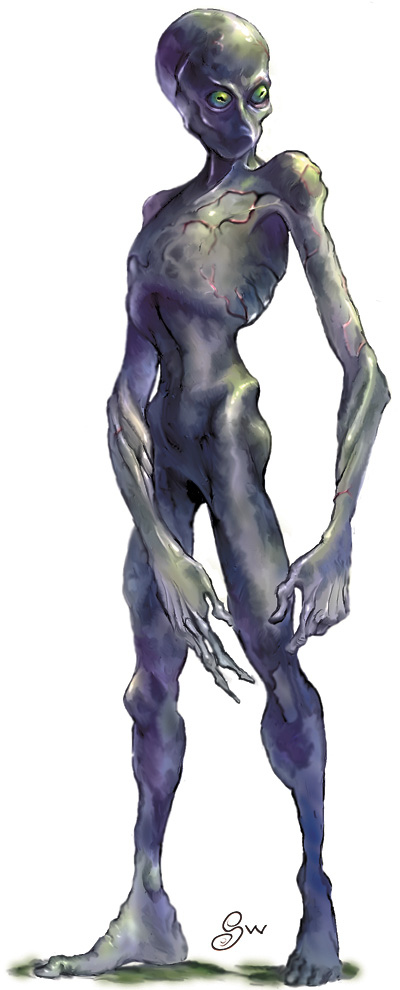
Doppelgangers are strange beings that are able to take on the shapes of those they encounter. In its natural form, the creature looks more or less humanoid, but slender and frail, with gangly limbs and half-formed features. The flesh is pale and hairless. Its large, bulging eyes are yellow with slitted pupils.
A doppelganger's appearance is deceiving even when it's in its true form. A doppelganger is hardy, with a natural agility not in keeping with its frail appearance.
Because they can take the shape of any humanoid between 4 and 8 feet tall, doppelgangers are natural spies and assassins. They can sneak past sentries, slip into secured places, and fool even lovers or close friends. They are cunning and patient, willing to wait until an opportunity presents itself instead of attacking rashly.
Doppelgangers make excellent use of their natural mimicry to stage ambushes, bait traps, and infiltrate humanoid society. Although not usually evil, they are interested only in themselves and regard all others as playthings to be manipulated and deceived. Spies supreme, doppelgangers infiltrate enemy territory, impersonate leaders, and probe enemies' minds for thoughts and plans.
When in its natural form, a doppelganger strikes with its powerful fists. In the shape of a warrior or some other armed person, it attacks with whatever weapon is appropriate. In such cases, it uses its detect thoughts ability to employ the same tactics and strategies as the person it is impersonating.
It is natural form a doppelganger is about 5-1/2 feet tall and weighs abut 150 pounds.
DOPPELGANGER RACIAL TRAITS
-
+2 Strength, +2, Dexterity, +2 Constitution, +2 Intelligence, +4 Wisdom, +2 Charisma.
-
Medium size.
-
A doppelganger's base land speed is 30 feet.
-
Darkvision: Doppelgangers can see in the dark up to 60 feet.
-
Racial Hit Dice: A doppelganger begins with four levels of monstrous humanoid, which provide 4d8 Hit Dice, a base attack bonus of +4, and base saving throw bonuses of Fort +1, Ref +4, and Will +4.
-
Racial Skills: A doppelganger's monstrous humanoid levels give it skill points equal to 7 x (2 + Int modifier). Its class skills are Bluff, Diplomacy, Disguise, Intimidate, Listen, Sense Motive, and Spot.
-
Racial Feats: A doppelganger's monstrous humanoid levels give it two feats.
-
+4 natural armor bonus.
-
Natural Weapons: Slam (1d6).
-
+4 racial bonus on Bluff and Disguise checks. When using its change shape ability, a doppelganger gets an additional +10 circumstance bonus on Disguise checks. If it can read an opponent's mind, it gets a further +4 circumstance bonus on Bluff and Disguise checks.
-
Detect Thoughts (Su): A doppelganger can continuously use Detect thoughts as the spell (caster level 18th; Will save negates). It can suppress or resume this ability as a free action. The save DC is Charisma-based.
-
Change Shape (Su): A doppelganger can assume the shape of any Small or Medium humanoid. In humanoid form, the doppelganger loses its natural attacks. A doppelganger can remain in its humanoid form until it chooses to assume a new one. A change in form cannot be dispelled, but a doppelganger reverts to its natural form when killed. A true seeing spell or ability reveals its natural form.
-
Immunity to sleep and charm effects.
-
Automatic Languages: Common. Bonus Languages: Auran, Dwarven, Elven, Gnome, Halfling, Giant, Terran.
-
Favored Class: Rogue.
-
Level adjustment +4.
GARGOYLES
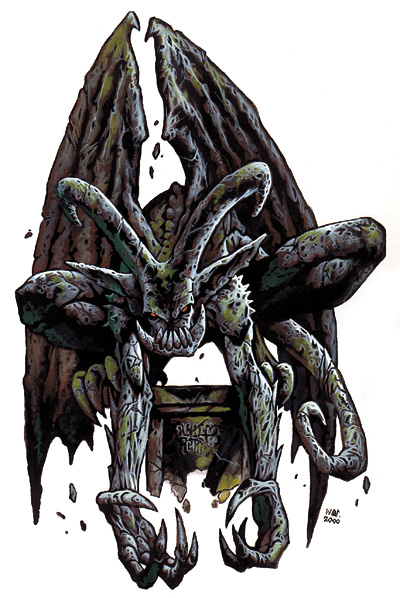
A gargoyle is a vicious flying predator that enjoys torturing creatures weaker than itself.
Gargoyles often appear to be winged stone statues, for they can perch indefinitely without moving and use this disguise to surprise their foes. They require no food, water, or air, but often eat their fallen foes out of fondness for inflicting pain. When not enjoying their favorite pastime, a wing of gargoyles can be found waiting silently for prey or bragging among themselves.
Gargoyles make excellent scouts, spies, and fighters. Able to soar aloft at a moment's notice, they can ravage their landbound foes and take aloft to the air. Gargoyles either remain still, then suddenly attack, or dive onto their prey.
GARGOYLE RACIAL TRAITS
-
+4 Strength, +4 Dexterity, +8 Constitution, -4 Intelligence, -4 Charisma.
-
Medium size.
-
A gargoyle's base land speed is 40 feet. It also has a fly speed of 60 feet (average).
-
Darkvision out to 60 feet.
-
Racial Hit Dice: A gargoyle begins with four levels of monstrous humanoid, which provide 4d8 Hit Dice, a base attack bonus of +4, and base saving throw bonuses of Fort +1, Ref +4, and Will +4.
-
Racial Skills: A gargoyle's monstrous humanoid levels give it skill points equal to 7 x (2 + Int modifier). Its class skills are Hide, Listen, and Spot. A gargoyle has a +2 racial bonus on Hide, Listen, and Spot checks, and an additional +8 bonus on Hide checks when it is concealed against a background of stone.
-
Racial Feats: A gargoyle's monstrous humanoid levels give it two feats.
-
+4 natural armor bonus.
-
Freeze (Ex): A gargoyle can hold itself so still it appears to be a statue. An observer must succeed on a DC 20 Spot check to notice the gargoyle is really alive.
-
Damage reduction 10/magic.
-
Automatic Languages: Common. Bonus Languages: Auran, Dwarven, Elven, Gnome, Halfling, Giant, Terran.
-
Favored Class: Fighter.
-
Level adjustment +5.
JANN
The jann (singular janni) are the weakest of the genies. Jann are formed out of all four elements and must therefore spend most of their time on the Material Plane. They favor forlorn deserts and hidden oases, where they have both privacy and safety.
Jann society is very open, treating males and females as equals. Each tribe is ruled by a sheik and one or two viziers. Exceptionally powerful sheiks are given the title of amir, and in times of need they gather and command large forces of jann (and sometimes allied humans).
Many jann bands are nomadic, traveling with herds of camels, goats, or sheep from oasis to oasis. These itinerant jann are often mistaken for humans - until they are attacked. The territory of a jann tribe can extend for hundreds of miles.
Jann are physically strong and courageous, and do not take kindly to insult or injury. If they meet a foe they cannot defeat in a stand-up fight, they use flight and invisibility to regroup and maneuver to a more advantageous position.
JANNI RACIAL TRAITS
-
+6 Strength, +4 Dexterity, +2 Constitution, +4 Intelligence, +4 Wisdom, +2 Charisma.
-
Medium size.
-
A janni's base land speed is 30 feet. It also has a fly speed of 20 feet (perfect).
-
Darkvision out to 60 feet.
-
Racial Hit Dice: A janni begins with six levels of outsider, which provide 6d8 Hit Dice, a base attack bonus of +6, and base saving throw bonuses of Fort +5, Ref +5, and Will +5.
-
Racial Skills: A janni's outsider levels give it skill points equal to 9 x (8 + Int modifier). Its class skills are Appraise, Concentration, Craft (any), Escape Artist, Listen, Move Silently, Ride, Sense Motive, and Spot.
-
Racial Feats: A janni's outsider levels give it three feats. A janni receives Improved Initiative as a bonus feat.
-
+1 natural armor bonus.
-
Change Size (Sp): Twice per day, a janni can magically change a creature's size. This works just like an enlarge person or reduce person spell (the janni chooses when using the ability), except that the ability can work on the janni. A Fortitude save negates the effect. The save DC is Charisma-based. This is the equivalent of a 2nd-level spell.
-
Spell-Like Abilities: Caster level 12th. The save DCs are Charisma-based.
3/day - invisibility (self only), speak with animals.�
Once per day a janni can create food and water (caster level 7th) and can use ethereal jaunt (caster level 12th) for 1 hour.
-
Elemental Endurance (Ex): Jann can survive on the Elemental Planes of Air, Earth, Fire, or Water for up to 48 hours. Failure to return to the Material Plane before that time expires causes a janni to take 1 point of damage per additional hour spent on the elemental plane, until it dies or returns to the Material Plane.
-
Plane Shift (Sp): A janni can enter any of the elemental planes, the Astral Plane, or the Material Plane. This ability transports the janni and up to eight other creatures, provided they all link hands with the janni. It is otherwise similar to the spell of the same name (caster level 13th).
-
Resistance to fire 10.
-
Telepathy 100 ft.
-
Automatic Languages: Common. Bonus Languages: Abyssal, Aquan, Auran, Celestial, Ignan, Infernal, Terran.
-
Favored Class: Rogue.
-
Level adjustment +5.
HILL GIANTS
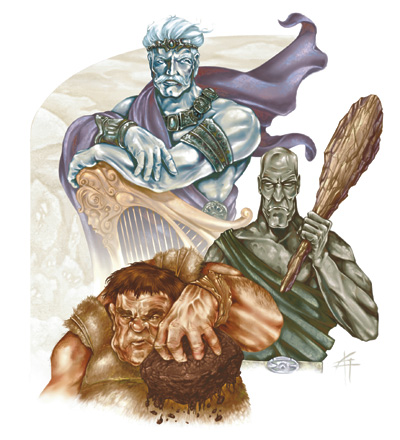
Hill giants are selfish, cunning brutes who survive through hunting and raiding.
Skin color among hill giants ranges from light tan to deep ruddy brown. Their hair is brown or black, with eyes the same color. Hill giants wear layers of crudely prepared hides with the fur left on. They seldom wash or repair their garments, preferring to simply add more hides as their old ones wear out.
Although hill giants prefer temperate areas, they can be found in practically any climate where there is an abundance of hills and mountains. Individuals and bands tend to be aggressive and prefer taking what they want over trading. Tribes (and some bands) often trade with other giants or with groups of ogres or orcs to get foodstuffs, trinkets, and servants.
Hill giants prefer to fight from high, rocky outcroppings, where they can pelt opponents with rocks and boulders while limiting the risk to themselves. Hill giants love to make overrun attacks against smaller creatures when they first join battle. Thereafter, they stand fast and swing away with their massive clubs.
A hill giant's bag usually contains 2d4 throwing rocks, 1d4+4 mundane items, and the giant's personal wealth. These possessions tend to be well worn, filthy, and stinky. The items are usually crude and often jury-rigged or salvaged from some similar item. Examples include a hand chopper made from a broken battleaxe head, a wooden bowl and spoon, or a drinking cup made from a big gourd or a skull.
Adults are about 10-1/2 feet tall and weigh about 1,100 pounds. Hill giants can live to be 200 years old.
HILL GIANT RACIAL TRAITS
-
+14 Strength, -2 Dexterity, +8 Constitution, -4 Intelligence, -4 Charisma.
-
Large size. -1 penalty to Armor Class, -1 penalty on attack rolls, -4 penalty on Hide checks, +4 bonus on grapple checks, lifting and carrying limits double those of Medium characters.
-
Space/Reach: 10 feet/10 feet.
-
A hill giant's base land speed is 40 feet.
-
Low-light vision.
-
Racial Hit Dice: A hill giant begins with twelve levels of giant, which provide 12d8 Hit Dice, a base attack bonus of +8, and base saving throw bonuses of Fort +8, Ref +4, and Will +4.
-
Racial Skills: A hill giant's giant levels give it skill points equal to 15 x (2 + Int modifier). Its class skills are Climb, Jump, Listen, and Spot.
-
Racial Feats: A hill giant's giant levels give it five feats.
-
+9 natural armor bonus.
-
Rock Throwing (Ex): Adult hill giants are accomplished rock throwers and receive a +1 racial bonus on attack rolls when throwing rocks. A hill giant can hurl rocks weighing 40 to 50 pounds each (Small objects) up to five range increments. The range increment is 120 feet.
-
Rock Catching (Ex): A hill giant can catch Small, Medium, or Large rocks (or projectiles of similar shape). Once per round, a hill giant that would normally be hit by a rock can make a Reflex save to catch it as a free action. The DC is 15 for a Small rock, 20 for a Medium one, and 25 for a Large one. (If the projectile provides a magical bonus on attack rolls, the DC increases by that amount.) The hill giant must be ready for and aware of the attack in order to make a rock catching attempt.
-
Weapon and Armor Proficiency: A hill giant is automatically proficient with simple weapons, martial weapons, light and medium armor, and shields.
-
Automatic Languages: Giant. Bonus Languages: Common, Draconic, Elven, Goblin, Orc.
-
Favored Class: Barbarian.
-
Level adjustment +4.
STONE GIANTS
Stone giants have a largely undeserved reputation as rock-throwing hooligans. In fact, they tend to be somewhat shy around strangers.
Stone giants prefer thick leather garments, dyed in shades of brown and gray to match the stone around them.
Stone giants may tend to be shy around strangers, but they are by no means timid. Many stone giants have an artistic streak. Some draw and paint scenes of their lives on the walls of their lairs and on tanned hide scrolls. Some are fond of music and play stone flutes and drums. Others make simple jewelry, fashioning painted stone beads into necklaces.
Most stone giants are playful, especially at night. They are fond of rock-throwing contests and other games that test their might. Groups of giants often gather to toss rocks at each other, the losing side being those who are hit more often. Travelers' reports of such contests have given stone giants their reputation for wildness.
Stone giants prefer to dwell in deep caves high on rocky, stormswept mountains. Usually, groups live fairly close together (no more than a day's travel apart) for a sense of community and protection. Most stone giant lairs have 2d4 neighboring lairs. Some older stone giants choose to live in solitude, meditating and creating artwork. Many of them become elders after several decades.
Most groups of stone giants subsist by hunting, gathering, and herding mountain animals such as sheep or goats. They trade with any other nearby communities, exchanging foodstuffs and stone goods for cloth, pottery, and manufactured items. Groups of evil giants often go raiding or extort tolls from mountain travelers. Stone giants fight from a distance whenever possible, but if they can't avoid melee, they use gigantic clubs chiseled out of stone. A favorite tactic of stone giants is to stand nearly motionless, blending in with the background, then move forward to throw rocks and surprise their foes.
A stone giant's bag usually contains 2d12 throwing rocks, 1d4+6 mundane items, and the giant's personal wealth. A stone giant's possessions are neither particularly clean nor particularly dirty, but most of them are made from stone.
Adults are about 12 feet tall and weigh about 1,500 pounds. Stone giants can live to be 800 years old.
STONE GIANT RACIAL TRAITS
-
+16 Strength, +4 Dexterity, +8 Constitution, +2 Wisdom.
-
Large size. -1 penalty to Armor Class, -1 penalty on attack rolls, -4 penalty on Hide checks, +4 bonus on grapple checks, lifting and carrying limits double those of Medium characters.
-
Space/Reach: 10 feet/10 feet.
-
A stone giant's base land speed is 40 feet.
-
Darkvision out to 60 feet and low-light vision.
-
Racial Hit Dice: A stone giant begins with fourteen levels of giant, which provide 14d8 Hit Dice, a base attack bonus of +10, and base saving throw bonuses of Fort +9, Ref +4, and Will +4.
-
Racial Skills: A stone giant's giant levels give it skill points equal to 17 x (2 + Int modifier). Its class skills are Climb, Hide, Listen, and Spot. A stone giant has a +8 racial bonus on Hide checks in rocky terrain.
-
Racial Feats: A stone giant's giant levels give it five feats.
-
+11 natural armor bonus.
-
Rock Throwing (Ex): Adult stone giants are accomplished rock throwers and receive a +1 racial bonus on attack rolls when throwing rocks. A stone giant can hurl rocks weighing 40 to 50 pounds each (Small objects) up to five range increments. The range increment is 180 feet for a stone giant's thrown rocks. It uses both hands when throwing a rock.
-
Rock Catching (Ex): A stone giant can catch Small, Medium, or Large rocks (or projectiles of similar shape). Once per round, a stone giant that would normally be hit by a rock can make a Reflex save to catch it as a free action. The DC is 15 for a Small rock, 20 for a Medium one, and 25 for a Large one. (If the projectile provides a magical bonus on attack rolls, the DC increases by that amount.) The stone giant must be ready for and aware of the attack in order to make a rock catching attempt. A stone giant gains a +4 racial bonus on its Reflex save when attempting to catch a thrown rock.
-
Automatic Languages: Giant. Bonus Languages: Common, Draconic, Elven, Goblin, Orc.
-
Favored Class: Barbarian.
-
Level adjustment +4.
GITHYANKI
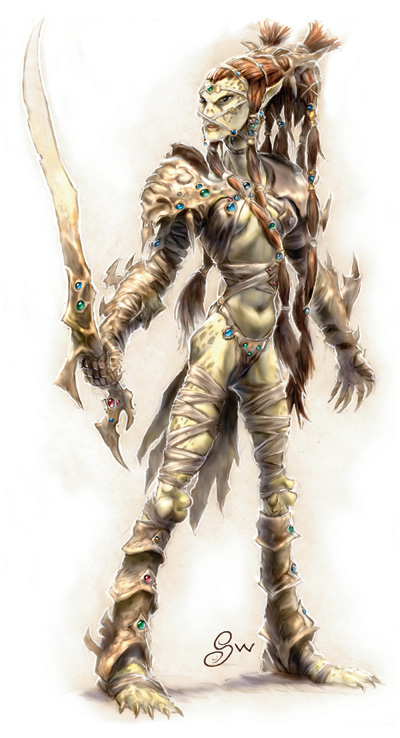
Githyanki are an ancient line of humanlike beings residing on the Astral Plane, filling their armories for their next skirmish, raid, or war.
Githyanki are gaunt, averaging a little over 6 feet tall and typically weighing around 170 pounds. They enjoy elaborate dress and baroque armor. In fact, they revere weapons and armor, and it is not uncommon for a githyanki to show more regard for panoply of possessions than for its mate.
Like dwarves, githyanki are craftmasters, although they focus exclusively on items of warfare. Their items are distinctive, and nongithyanki who acquire them run the risk of immediate retribution should they encounter githyanki.
Githyanki are seasoned combatants, familiar with the tactical use of ambush, cover, and psionic sniper attacks from afar. However, they prefer to engage their enemies in hand-to-hand combat so they can bring their devastating melee weapons to bear. Githyanki weapons are usually greatswords, bastard swords, and other particularly large-bladed weapons of special githyanki manufacture, all masterwork and each distinctively decorated and named. Githyanki wizards direct their powers with pinpoint accuracy to support their comrades in melee.
In eons past, the mind flayers enslaved entire races, including the forerunners of the githyanki. Centuries of captivity bred hatred, nurtured resolve, and finally instilled psionic powers into these slaves. With mental armaments of their own and a powerful leader to rally behind (the legendary Gith), the slaves instigated a cross-planar struggle that, in the end, threw down the mind flayer empire, bringing freedom to the surviving slaves. However, these survivors soon split into the racially distinct githyanki and their mortal enemies, the githzerai (see the Githzerai entry, below). Each constantly attempts the extinction of the other. This animosity has burned through the centuries, warping the githyanki into the evil, militaristic creatures they are today. Both creatures' hatred of mind flayers knows no bounds, though, and they will break off hostilities to slay illithids if the opportunity presents itself.
Githyanki live within massive fortresses adrift in the Astral Plane. Here they conduct commerce, manufacture goods, grow food, and live out their lives. Family dwellings are nonexistent, since most githyanki prefer their own abode; however, githyanki are often found in groups, honing their fighting skills. A fortress contains noncombatants (mostly children) equal to 20% of the fighting population. Githyanki males and females may be found in almost any role or class.
The githyanki have no deity but instead pay homage to a lich-queen. A jealous and paranoid overlord, she devours the essence of any githyanki that rises above 16th level. In addition to eliminating a potential rival, the lich-queen enhances her power with the stolen life essence.
GITHYANKI RACIAL TRAITS
-
+2 Dexterity, +2 Constitution, -2 Wisdom.
-
Medium size.
-
A githyanki's base land speed is 30 feet.
-
Darkvision out to 60 feet.
-
Racial Feats: A githyanki character gains feats according to its character class.
-
Psionics (Sp): 3/day - daze, mage hand. In addition, githyanki of 3rd level or higher can use blur three times per day, githyanki of 6th level or higher can use dimension door three times per day, and githyanki of 9th level or higher can use telekinesis three times per day and plane shift once per day. Effective caster level equals the githyanki's class levels. The save DCs are Charisma-based.
-
Spell resistance equal to class levels +5.
-
Red Dragon Pact: Githyanki have a racial pact with red dragons, which sometimes serve githyanki as mounts. Individually, githyanki have a +4 racial bonus on Diplomacy checks when dealing with red dragons. In large groups, they can make temporary alliances with red dragons at the option of the Dungeon Master.
-
Automatic Languages: Githyanki. Bonus Languages: Common, Infernal, Draconic, Undercommon.
-
Favored Class: Fighter.
-
Level adjustment +2.
GITHZERAI
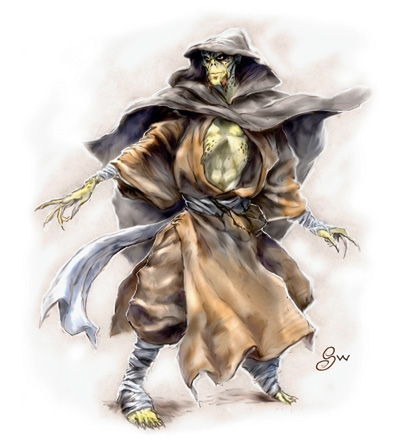
Githzerai are a hard-hearted, humanlike people who dwell on the plane of Limbo, secure in the protection of their hidden monasteries.
Githzerai average more than 6 feet tall and weigh about 160 pounds. Some have gray eyes instead of yellow. All of them dress in drab, unadorned clothing.
As a rule, githzerai are close-mouthed, keep their own counsel, and trust few outside their own kind. Able to fight without weapons and armor, githzerai monks yearn to bring the "good fight" to their enemies, the githyanki and the mind flayers. In melee, githzerai sorcerers often use their powers to enhance the monks, warriors, and rogues.
The githzerai forerunners united under the command of the rebel Gith (see the Githyanki entry, above) and threw down the plane-spanning empire of the mind flayers. Once free, the former slaves split ideologically and eventually racially, becoming the githzerai and their foes, the githyanki. The githzerai's history of imprisonment was the foundation of their monastic lifestyle, in which all githzerai learn from childhood how to eradicate potential oppressors and enemies (anyone not a githzerai).
Githzerai live within self-contained, fortresslike monasteries hidden deep in the swirling chaos of Limbo. While disorder rules outside, stability holds sway inside. Each monastery is ultimately under the control of a sensei, a monk of at least 16th level, and follows a strict schedule of chants, meals, martial arts training, and devotions, according to a particular sensei's philosophy. A monastery contains noncombatants (mostly children) equal to 15% of the fighting population. Githzerai males and females may be found in almost any role or class.
GITHZERAI RACIAL TRAITS
-
+6 Dexterity, -2 Intelligence, +2 Wisdom.
-
Medium size.
-
A githzerai's base land speed is 30 feet.
-
Darkvision out to 60 feet.
-
Racial Feats: A githzerai gains feats according to its character class.
-
Psionics (Sp): 3/day - daze, feather fall, shatter. A githzerai of 11th level or higher can use plane shift once per day. Effective caster level equals the githzerai's class levels. The save DCs are Charisma-based.
-
Inertial Armor (Sp): Githzerai can use psychic force to block an enemy's blows. This ability gives them a +4 armor bonus to AC as long as they remain conscious. This is the equivalent of a 1st-level spell.
-
Spell resistance equal to class levels + 5.
-
Automatic Languages: Githzerai. Bonus Languages: Common, Slaad, Undercommon.
-
Favored Class: Monk.
-
Level adjustment +2.
GNOLLS
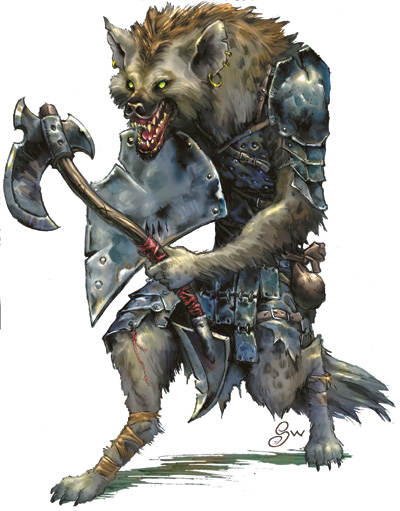
Gnolls are hyena-headed, evil humanoids that wander in loose tribes.
A gnoll is a nocturnal carnivore, preferring intelligent creatures for food because they scream more. Gnolls tend to think with their stomachs, and any alliances they make (usually with bugbears, hobgoblins, ogres, orcs, or trolls) often fall apart when the gnolls get hungry. They dislike giants and most other humanoids, and they disdain manual labor.
Gnolls like to attack when they have the advantage of numbers, using horde tactics and their physical strength to overwhelm and knock down their opponents. They show little discipline when fighting unless they have a strong leader; at such times, they can maintain ranks and fight as a unit. While they do not usually prepare traps, they do use ambushes and try to attack from a flanking position. Gnolls always take special care to seek favorable conditions when laying ambushes (such as darkness, cover, or some other form of advantageous terrain).
A tribe of gnolls is ruled by its strongest member, who uses fear, intimidation, and strength to remain in power. If a chieftain is killed, the stronger members of the tribe fight to be the new chieftain; if these combats take too long or several combatants die, the tribe may break up into a number of bands that go their separate ways. Gnolls revere the phases of the moon, but most tribes have no true clerics.
A band or tribe includes as many noncombatant young as there are adults. Gnoll lairs are fortified surface encampments or underground complexes. Gnolls take prisoners for use as slaves, and any lair will have at least one slave for every ten adults. Slaves (usually humans, orcs, or hobgoblins) suffer a high attrition rate because of the gnolls' appetite.
Their special patron is the demon lord Yeenoghu, who looks like a gaunt gnoll. Most gnolls serve and revere Yeenoghu rather than worshiping a deity. A gnoll cleric has access to two of the following domains: Chaos, Evil, Trickery, or War (favored weapon morningstar).
Most gnolls have dirty yellow or reddish-brown fur. A gnoll is about 7-1/2 feet tall and weighs 300 pounds.
GNOLL RACIAL TRAITS
-
+4 Strength, +2 Constitution, -2 Intelligence, -2 Charisma.
-
Medium size.
-
A gnoll's base land speed is 30 feet.
-
Darkvision out to 60 feet.
-
Racial Hit Dice: A gnoll begins with two levels of humanoid, which provide 2d8 Hit Dice, a base attack bonus of +1, and base saving throw bonuses of Fort +3, Ref +0, and Will +0.
-
Racial Skills: A gnoll's humanoid levels give it skill points equal to 5 x (2 + Int modifier). Its class skills are Listen and Spot.
-
Racial Feats: A gnoll's humanoid levels give it one feat.
-
+1 natural armor bonus.
-
Automatic Languages: Gnoll. Bonus Languages: Common, Draconic, Elven, Goblin, Orc.
-
Favored Class: Ranger.
-
Level adjustment +1.
GOBLINS
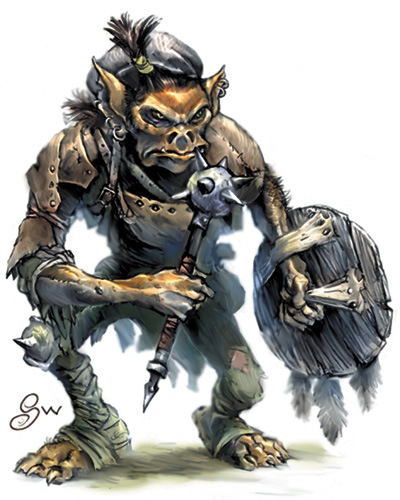
Goblins are small humanoids that many consider little more than a nuisance. However, if they are unchecked, their great numbers, rapid reproduction, and evil disposition enable them to overrun and despoil civilized areas.
Being bullied by bigger, stronger creatures has taught goblins to exploit what few advantages they have: sheer numbers and malicious ingenuity. The concept of a fair fight is meaningless in their society. They favor ambushes, overwhelming odds, dirty tricks, and any other edge they can devise.
Goblins have a poor grasp of strategy and are cowardly by nature, tending to flee the field if a battle turns against them. With proper supervision, though, they can implement reasonably complex plans, and in such circumstances their numbers can be a deadly advantage.
Goblins are tribal. Their leaders are generally the biggest, strongest, or sometimes the smartest of the group. They have almost no concept of privacy, living and sleeping in large common areas; only the leaders live separately. Goblins survive by raiding and stealing (preferably from those who cannot defend themselves easily), sneaking into lairs, villages, and even towns by night to take what they can. They are not above waylaying travelers on the road or in forests and stripping them of all possessions, up to and including the clothes on their backs. Goblins sometimes capture slaves to perform hard labor in the tribe's lair or camp.
These creatures live wherever they can, from dank caves to dismal ruins, and their lairs are always smelly and filthy due to an utter lack of sanitation. Goblins often settle near civilized areas to raid for food, livestock, tools, weapons, and supplies. Once a tribe has despoiled a locale, it simply packs up and moves on to the next convenient area. Hobgoblins and bugbears are sometimes found in the company of goblin tribes, usually as bullying leaders. Some goblin tribes form alliances with worgs, which carry them into combat. Goblin bands and tribes have noncombatant young equal in number to the adults.
The chief goblin deity is Maglubiyet, who urges his worshipers to expand their numbers and overwhelm their competitors. A goblin cleric has access to two of the following domains: Chaos, Evil, or Trickery.
A goblin stands 3 to 3-1/2 feet tall and weigh 40 to 45 pounds. Its eyes are usually dull and glazed, varying in color from red to yellow. A goblin's skin color ranges from yellow through any shade of orange to a deep red; usually all members of a single tribe are about the same color. Goblins wear clothing of dark leather, tending toward drab, soiled-looking colors.
GOBLIN RACIAL TRAITS
-
-2 Strength, +2 Dexterity, -2 Charisma.
-
Small size: +1 bonus to Armor Class, +1 bonus on attack rolls, +4 bonus on Hide checks, -4 penalty on grapple checks, lifting and carrying limits 3/4 those of Medium characters.
-
A goblin's base land speed is 30 feet.
-
Darkvision out to 60 feet.
-
+4 racial bonus on Move Silently and Ride checks.
-
Automatic Languages: Common, Goblin. Bonus Languages: Draconic, Elven, Giant, Gnoll, Orc.
-
Favored Class: Rogue.
GRIMLOCKS
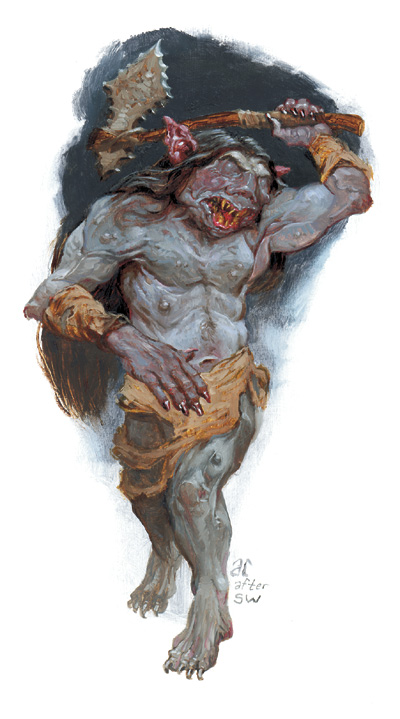
Grimlocks are natives of the deep places beneath the earth but come to the surface to raid for slaves and pillage. While there, they lurk in mountainous terrain, which hides them well. They prefer raw, fresh meat - preferably human.
Extremely xenophobic, grimlocks are normally encountered in small patrols or packs on the surface. Underground, they may form larger communities that are led by powerful grimlocks or by some more intelligent creature, such as a medusa or a mind flayer.
Grimlocks are blind, but their exceptional senses of smell and hearing allow them to notice foes nearby. As a result, they usually shun ranged weapons and rush to the attack, brandishing their stone battleaxes.
GRIMLOCK RACIAL TRAITS
-
+4 Strength, +2 Dexterity, +2 Constitution, -2 Wisdom, -4 Charisma.
-
Medium size.
-
A grimlock's base land speed is 30 feet.
-
Racial Hit Dice: A grimlock begins with two levels of monstrous humanoid, which provide 2d8 Hit Dice, a base attack bonus of +2, and base saving throw bonuses of Fort +0, Ref +3, and Will +3.
-
Racial Skills: A grimlock's monstrous humanoid levels give it skill points equal to 5 x (2 + Int modifier, minimum 1). Its class skills are Climb, Hide, Listen, and Spot. Grimlocks gain a +10 racial bonus on Hide checks in mountain or underground settings.
-
Racial Feats: A grimlock's monstrous humanoid levels give it one feat.
-
Weapon Proficiency: A grimlock is automatically proficient with the battleaxe.
-
+4 natural armor bonus.
-
Blindsight (Ex): Grimlocks can sense all foes within 40 feet as a sighted creature would. Beyond that range, they treat all targets as having total concealment.
Grimlocks are susceptible to sound- and scent-based attacks, however, and are affected normally by loud noises and sonic spells (such as ghost sound or silence) and overpowering odors (such as stinking cloud or incense-heavy air). Negating a grimlock's sense of smell or hearing reduces this ability to normal Blind-Fight (as the feat). If both these senses are negated, a grimlock is effectively blinded.
-
Immunities: Grimlocks are immune to gaze attacks, visual effects, illusions, and other attack forms that rely on sight.
-
Automatic Languages: Common, Grimlock. Bonus Languages: Draconic, Dwarven, Gnome, Terran, Undercommon.
-
Favored Class: Barbarian.
-
Level adjustment +2.
HOBGOBLINS
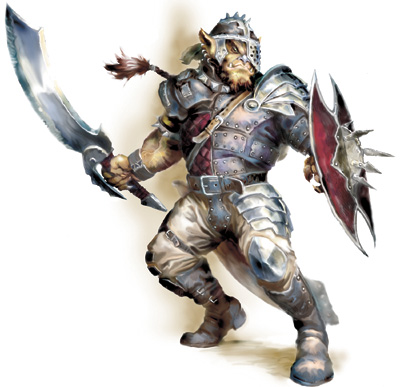
Hobgoblins are larger cousins of goblins. They are far more aggressive and organized than their smaller relatives and wage a perpetual war with other humanoids, particularly elves.
Hobgoblins' hair color ranges from dark reddish-brown to dark gray. They have dark orange or red-orange skin. Large males have blue or red noses. Hobgoblins' eyes are yellowish or dark brown, while their teeth are yellow. Their garments tend to be brightly colored, often blood red with black-tinted leather. Their weaponry is kept polished and in good repair These creatures have a strong grasp of strategy and tactics and are capable of carrying out sophisticated battle plans. Under the leadership of a skilled strategist or tactician, their discipline can prove a deciding factor. Hobgoblins hate elves and attack them first, in preference to other opponents.
Hobgoblins are a military breed: They live for war and believe strongly in strength and martial prowess as the most desirable qualities for individuals and leaders alike. A hobgoblin leader is likely to be the biggest and strongest in the group, maintaining authority by enforcing strict discipline. Hobgoblins are often leaders among tribes of goblins and orcs, whom they bully and treat as inferiors. Hobgoblin mercenaries sometimes enter the service of wealthy evil humanoids.
Hobgoblin society is organized into tribal bands, each intensely jealous of its reputation and status. Meetings between rival bands are likely to erupt in violence if the troops are not restrained. Only an exceptionally powerful leader can force them to cooperate for any length of time. Each band has a distinctive battle standard that it carries into combat to inspire, rally, and signal the troops. Hobgoblin gangs and warbands are almost exclusively male. Bands and tribes include females who help with defense. Noncombatant hobgoblins are children too young to fight effectively.
These creatures usually make lairs in places that either boast natural defenses or can be fortified. Cavern complexes, dungeons, ruins, and forests are among their favorites. Typical lair defenses include ditches, fences, gates, guard towers, pit traps, and crude catapults or ballistas.
Most hobgoblins revere Maglubiyet, who is also the patron deity of goblins. A hobgoblin cleric has access to two of the following domains: Evil, Destruction, or Trickery.
HOBGOBLIN RACIAL TRAITS
-
+2 Dexterity, +2 Constitution.
-
A hobgoblin's base land speed is 30 feet.
-
Darkvision out to 60 feet.
-
+4 racial bonus on Move Silently checks.
-
Automatic Languages: Common, Goblin. Bonus Languages: Draconic, Dwarven, Infernal, Giant, Orc.
-
Favored Class: Fighter.
-
Level adjustment +1.
KOBOLDS
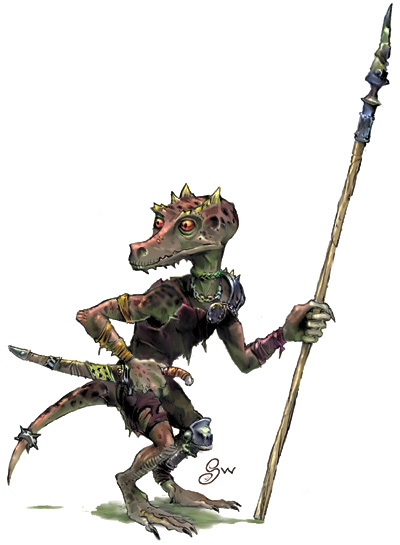
Kobolds are short, reptilian humanoids with cowardly and sadistic tendencies.
A kobold's scaly skin ranges from dark rusty brown to a rusty black color. It has glowing red eyes. Its tail is nonprehensile. Kobolds wear ragged clothing, favoring red and orange.
Kobolds usually consume plants or animals but are not averse to eating intelligent beings. They spend most of their time fortifying the land around their lairs with traps and warning devices (such as spiked pits, tripwires attached to crossbows, and other mechanical contraptions).
Kobolds hate almost every other sort of humanoid or fey, especially gnomes and sprites.
Kobolds like to attack with overwhelming odds - at least two to one - or trickery; should the odds fall below this threshold, they usually flee. However, they attack gnomes on sight if their numbers are equal.
They begin a fight by slinging bullets, closing only when they can see that their foes have been weakened. Whenever they can, kobolds set up ambushes near trapped areas. They aim to drive enemies into the traps, where other kobolds wait to pour flaming oil over them, shoot them, or drop poisonous vermin onto them.
Kobolds live in dark places, usually underground locations and overgrown forests. They are good miners and often live in the mines they are developing. A kobold tribe sends out warbands that patrol within a 10-mile radius from the lair, attacking any intelligent creatures that enter their territory. Kobolds usually kill prisoners for food but occasionally sell some of them as slaves. Their nasty habits and their distrust of most other beings mean that they have many enemies. A kobold lair has one noncombatant child and one egg per ten adults.
The patron deity of the kobolds is Kurtulmak, who despises all living creatures except kobolds.
A kobold is 2 to 2-1/2 feet tall and weighs 35 to 45 pounds.
KOBOLD RACIAL TRAITS
-
-4 Strength, +2 Dexterity, -2 Constitution.
-
Small size: +1 bonus to Armor Class, +1 bonus on attack rolls, +4 bonus on Hide checks, -4 penalty on grapple checks, lifting and carrying limits 3/4 those of Medium characters.
-
A kobold's base land speed is 30 feet.
-
Darkvision out to 60 feet.
-
Racial Skills: A kobold character has a +2 racial bonus on Craft (trapmaking), Profession (miner), and Search checks.
-
+1 natural armor bonus.
-
Light Sensitivity (Ex): Kobolds are dazzled in bright sunlight or within the radius of a daylight spell.
-
Automatic Languages: Draconic. Bonus Languages: Common, Undercommon.
-
Favored Class: Sorcerer.
LIZARDFOLK
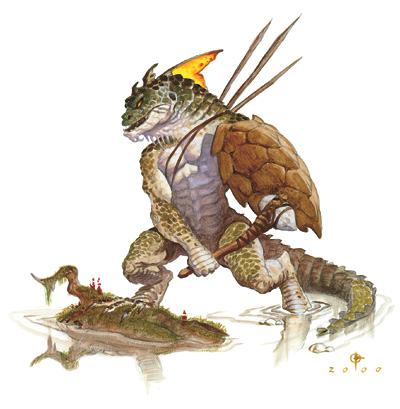
Lizardfolk are primitive reptilian humanoids that can be very dangerous if provoked.
Although they are omnivores, lizardfolk prefer meat; popular lore holds that lizardfolk prefer humanoid flesh, but this charge is largely unfounded (though some tribes do eat captives or slain foes). Some more advanced tribes build huts and use a variety of weapons and shields; leaders of these tribes may have equipment stolen from or obtained in trade with other intelligent creatures.
Lizardfolk fight as unorganized individuals. They prefer frontal assaults and massed rushes, sometimes trying to force foes into the water, where the lizardfolk have an advantage. If outnumbered or if their territory is being invaded, they set snares, plan ambushes, and make raids to hinder enemy supplies. Advanced tribes use more sophisticated tactics and have better traps and ambushes.
Lizardfolk have a patriarchal society in which the most powerful member rules the others. Shamans offer advice but rarely become leaders themselves. Survival is the utmost concern of lizardfolk, and a threatened or starving tribe will go to incredible lengths (even committing deeds considered abominable by other humanoids) to ensure its continued existence.
Most tribes live in swamps, but about a third of the population lives in underwater air-filled caves. Local tribes often unite against a greater threat (including hostile lizardfolk tribes) and occasionally make alliances with locathahs or serve more powerful creatures such as nagas or dragons. In isolated areas they survive by fishing, gathering, and scavenging, while those that live near other humanoids make raids for food, supplies, and slaves. A lizardfolk lair has half as many noncombatant hatchlings as adults, and one egg per ten adults.
The patron deity of lizardfolk is Semuanya, whose chief concern is the survival and propagation of its charges. A lizardfolk clertic has access to two of the following domains: Animal, Plant, or Water.
A lizardfolk is usually 6 to 7 feet tall with green, gray, or brown scales. Its tail is used for balance and is 3 to 4 feet long. A lizardfolk can weigh from 200 to 250 pounds.
LIZARDFOLK RACIAL TRAITS
-
+2 Strength, +2 Constitution, -2 Intelligence.
-
Medium size.
-
A lizardfolk's base land speed is 30 feet.
-
Racial Hit Dice: A lizardfolk begins with two levels of humanoid, which provide 2d8 Hit Dice, a base attack bonus of +1, and base saving throw bonuses of Fort +0, Ref +3, and Will +0.
-
Racial Skills: A lizardfolk's humanoid levels give it skill points equal to 5 x (2 + Int modifier, minimum 1). Its class skills are Balance, Jump, and Swim. Lizardfolk have a +4 racial bonus on Balance, Jump, and Swim checks.
-
Racial Feats: A lizardfolk's humanoid levels give it one feat.
-
Weapon and Armor Proficiency: A lizardfolk is automatically proficient with simple weapons and shields.
-
+5 natural armor bonus.
-
Natural Weapons: 2 claws (1d4) and bite (1d4).
-
Hold Breath: A lizardfolk can hold its breath for a number of rounds equal to four times its Constitution score before it risks drowning.
-
Automatic Languages: Common, Draconic. Bonus Languages: Aquan, Goblin, Gnoll, Orc.
-
Favored Class: Druid.
-
Level adjustment +1.
LYCANTHROPES
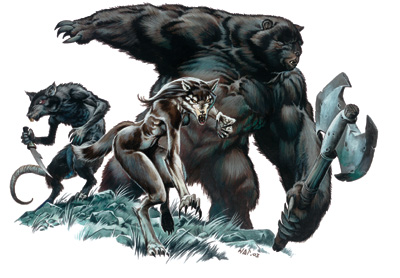
Lycanthropes are humanoids or giants who can transform themselves into animals. In its natural form, a lycanthrope looks like any other members of its kind, though natural lycanthropes and those who have been afflicted for a long time tend to have or acquire features reminiscent of their animal forms, such as thick, shaggy hair, pointed teeth, or long, strong fingers. In animal form, a lycanthrope resembles a powerful version of the normal animal, but on close inspection, its eyes (which often glow red in the dark) show a faint spark of unnatural intelligence.
Evil lycanthropes often hide among normal folk, emerging in animal form at night (especially under a full moon) to spread terror and bloodshed. Good lycanthropes tend to be reclusive individuals, uncomfortable around large numbers of people. They often live alone in wilderness areas, far from villages and towns.
Lycanthropy can be spread like a disease. Sometimes a lycanthrope begins life as a normal humanoid or giant who subsequently contracts lycanthropy after being wounded by a lycanthrope. Such a creature is called an afflicted lycanthrope. Other lycanthropes are born as lycanthropes, and are known as natural lycanthropes.
A lycanthrope in its humanoid (or giant) form uses whatever tactics and weapons are favored by others of its kind, though it tends to be slightly more aggressive. A lycanthrope possesses the senses of its animal form, including scent and low-light vision, and it has a deep empathy for (and ability to communicate with) animals of its animal form. An afflicted lycanthrope damaged in combat may be overwhelmed by rage, causing it to change to its animal form involuntarily.
A lycanthrope in animal form fights like the animal it resembles, although its bite carries the disease of lycanthropy. It is preternaturally cunning and strong, and possesses damage reduction that is overcome only by silvered weapons.
Finally, a natural lycanthrope (or an afflicted lycanthrope that has become aware of its affliction) can assume a hybrid form that is a mix of its humanoid and animal forms. A hybrid has hands and can use weapons, but it can also attack with its teeth and claws. A hybrid can spread lycanthropy with its bite, and it has the same damage reduction that its animal form possesses.
LYCANTHROPE RACIAL TRAITS
-
+2 Wisdom. Physical abilities are increased by the animal form's ability modifiers when a lycanthrope changes to its hybrid or animal forms.
-
Same size as the base creature or the base animal form.
-
Low-light vision in any form.
-
Scent in any form.
-
Racial Hit Dice: A lycanthrope adds the Hit Dice of its animal form to its base Hit Dice for race, level, and class. These additional Hit Dice modify the lycanthrope's base attack bonus and base saving throw bonuses accordingly.
-
Racial Skills: A lycanthrope adds skill points for its animal Hit Dice much as if it had multiclassed into the animal type. It gains skill points equal to (2 + Int modifier, minimum 1) per Hit Die of the animal form. Any skills that appear in the animal's description are treated as class skills for the lycanthrope's animal levels. The lycanthrope's maximum skill ranks are equal to its animal form Hit Dice + its racial Hit Dice (if any) + its class levels + 3. Any racial skill adjustments of the lycanthrope's base race and its animal form (but not conditional adjustments) are added to its skill modifiers in any form.
-
Racial Feats: Add the animal's Hit Dice to the base character's own Hit Dice to determine how many feats the character has. All lycanthropes gain Iron Will as a bonus feat.
-
+2 natural armor bonus in any form.
-
Alternate Form (Su): A lycanthrope can shift into animal form as though using the polymorph spell on itself, though its gear is not affected, it does not regain hit points for changing form, and only the specific animal form indicated for the lycanthrope can be assumed. It does not assume the ability scores of the animal, but instead adds the animal's physical ability score modifiers to its own ability scores. A lycanthrope also can assume a bipedal hybrid form with prehensile hands and animalistic features. Changing to or from animal or hybrid form is a standard action. A slain lycanthrope reverts to its humanoid form, although it remains dead. Separated body parts retain their animal form, however. Afflicted lycanthropes find this ability difficult to control, but natural lycanthropes have full control over this power.
-
Damage Reduction (Ex): An afflicted lycanthrope in animal or hybrid form has damage reduction 5/silver. A natural lycanthrope in animal or hybrid form has damage reduction 10/silver.
-
Lycanthropic Empathy (Ex): In any form, lycanthropes can communicate and empathize with normal or dire animals of their animal form. This gives them a +4 racial bonus on checks when influencing the animal's attitude and allows the communication of simple concepts and (if the animal is friendly) commands, such as "friend," "foe," "flee," and "attack."
-
Curse of Lycanthropy (Su): Any humanoid or giant hit by a natural lycanthrope's bite attack in animal or hybrid form must succeed on a DC 15 Fortitude save or contract lycanthropy. If the victim's size is not within one size category of the lycanthrope (for example, a hill giant bitten by a wererat), the victim cannot contract lycanthropy from that lycanthrope. Afflicted lycanthropes cannot pass on the curse of lycanthropy.
-
Automatic Languages: As base creature.
-
Favored Class: Same as the base creature.
-
Level adjustment: Same as the base creature +2 (afflicted) or +3 (natural).
MIND FLAYERS
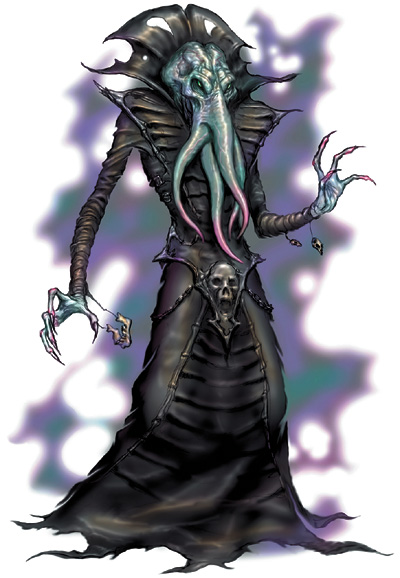
Mind flayers, also called illithids, are so insidious, diabolical, and powerful that all denizens of the dark fear them. They bend others to their will and shatter enemies' minds.
A mind flayer's mouth, a revolting thing shaped like a lamprey's maw, constantly drips an oily slime when it is not siphoning out the brains of living prey. In addition to being highly intelligent, wholly evil, and terribly sadistic, mind flayers are utterly self-serving. If an encounter turns against the creature, it flees at once, caring nothing for the fate of its companions or servitors.
Mind flayers like to fight from a distance, using their psionic abilities, particularly mind blast. If pressed into melee combat, a mind flayer lashes its enemies with the tentacles ringing its mouth.
Mind flayers congregate in underground cities of 200 to 2,000 inhabitants, plus at least two slaves for each resident. Slaves obey their masters without question. The center of a community is its elder brain, a pool of briny fluid that contains the brains of the city's deceased mind flayers.
Although they constantly vie for power, mind flayers are quite willing to work together. A small group of these creatures, known as an inquisition, often forms to root out some dark and terrible secret. In many ways, a mind flayer inquisition is not unlike a party of adventurers, with each member contributing its own skills and knowledge to the group. When a task is too great for an inquisition to handle, mind flayers generally form a cult. A pair of illithids commands the group, each struggling for supremacy.
MIND FLAYER RACIAL TRAITS
-
+2 Strength, +4 Dexterity, +2 Constitution, +8 Intelligence, +6 Wisdom, +6 Charisma.
-
Medium size.
-
A mind flayer's base land speed is 30 feet.
-
Darkvision out to 60 feet.
-
Racial Hit Dice: A mind flayer begins with eight levels of aberration, which provide 8d8 Hit Dice, a base attack bonus of +6, and base saving throw bonuses of Fort +2, Ref +2, and Will +6.
-
Racial Skills: A mind flayer's aberration levels give it skill points equal to 11 × (2 + Int modifier). Its class skills are Bluff, Concentration, Hide, Intimidate, Knowledge (any), Listen, Move Silently, and Spot.
-
Racial Feats: A mind flayer's aberration levels give it three feats.
-
+3 natural armor bonus.
-
Natural Weapons: 4 tentacles (1d4).
-
Mind Blast (Sp): This psionic attack is a cone 60 feet long. Anyone caught in this cone must succeed on a Will save or be stunned for 3d4 rounds. Mind flayers often hunt using this power and then drag off one or two of their stunned victims to feed upon. The save DC is Charisma-based. This ability is the equivalent of a 4th-level spell.
-
Psionics (Sp): At will - charm monster, detect thoughts, levitate, plane shift, suggestion. Effective caster level 8th. The save DCs are Charisma-based.
-
Improved Grab (Ex): To use this ability, a mind flayer must hit a Small, Medium, or Large creature with its tentacle attack. It can then attempt to start a grapple as a free action without provoking an attack of opportunity. If it wins the grapple check, it establishes a hold and attaches the tentacle to the opponent's head. A mind flayer can grab a Huge or larger creature, but only if it can somehow reach the foe's head. If a mind flayer begins its turn with at least one tentacle attached, it can try to attach its remaining tentacles with a single grapple check. The opponent can escape with a single successful grapple check or an Escape Artist check, but the mind flayer gets a +2 circumstance bonus for every tentacle that was attached at the beginning of the opponent's turn.
-
Extract (Ex): A mind flayer that begins its turn with all four tentacles attached and that makes a successful grapple check automatically extracts the opponent's brain, instantly killing that creature. This power is useless against constructs, elementals, oozes, plants, and undead. It is not instantly fatal to foes with multiple heads, such as ettins and hydras.
-
Spell resistance equal to 25 + class levels.
-
Telepathy 100 ft.
-
Automatic Languages: Common, Undercommon. Bonus Languages: Abyssal, Aquan, Draconic, Dwarven, Elven, Gnome, Infernal, Terran.
-
Favored Class: Wizard.
-
Level adjustment +7.
MINOTAURS
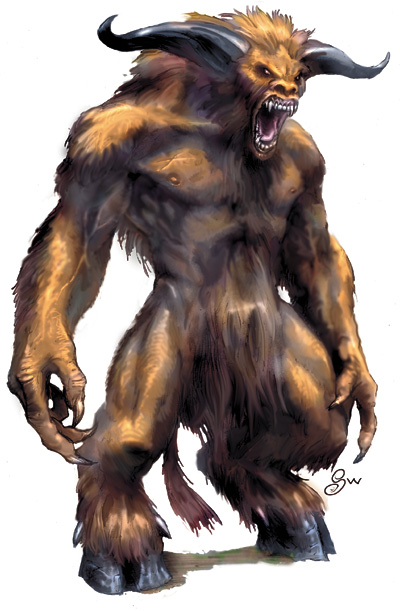
Minotaurs are strong, fiercely territorial creatures often found in vast underground labyrinths.
A minotaur's natural cunning and feral instincts enable it to find its way easily through even the most confusing tunnel complexes - an ability it puts to great use in hunting, tormenting, and ultimately destroying intruders.
Minotaurs prefer melee combat, where their great strength serves them well.
MINOTAUR RACIAL TRAITS
-
+8 Strength, +4 Constitution, -4 Intelligence (minimum 3), -2 Charisma.
-
Large size. -1 penalty to Armor Class, -1 penalty on attack rolls, -4 penalty on Hide checks, +4 bonus on grapple checks, lifting and carrying limits double those of Medium characters.
-
Space/Reach: 10 feet/10 feet.
-
A minotaur's base land speed is 30 feet.
-
Darkvision out to 60 feet.
-
Racial Hit Dice: A minotaur begins with six levels of monstrous humanoid, which provide 6d8 Hit Dice, a base attack bonus of +6, and base saving throw bonuses of Fort +2, Ref +5, and Will +5.
-
Racial Skills: A minotaur's monstrous humanoid levels give it skill points equal to 9 x (2 + Int modifier, minimum 1). Its class skills are Intimidate, Jump, Listen, Search, and Spot. Minotaurs have a +4 racial bonus on Search, Spot, and Listen checks.
-
Racial Feats: A minotaur's monstrous humanoid levels give it three feats.
-
Weapon Proficiency: A minotaur is proficient with the greataxe and all simple weapons.
-
+5 natural armor bonus.
-
Natural Weapons: Gore (1d8).
-
Powerful Charge (Ex): A minotaur typically begins a battle by charging at an opponent, lowering its head to bring its mighty horns into play. In addition to the normal benefits and hazards of a charge, this allows the beast to make a single gore attack that deals 4d6 plus 1 1/2 Strength bonus points of damage.
-
Natural Cunning (Ex): Although minotaurs are not especially intelligent, they possess innate cunning and logical ability. This gives them immunity to maze spells, prevents them from ever becoming lost, and enables them to track enemies. Further, they are never caught flat-footed.
-
Automatic Languages: Common, Giant. Bonus Languages: Orc, Goblin, Terran.
-
Favored Class: Barbarian.
-
Level adjustment +2.
OGRES
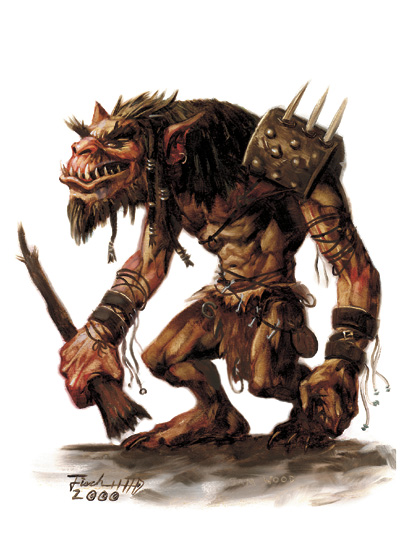
Ogres are big, ugly, greedy creatures that live by raiding and scavenging. They join other monsters to prey on the weak and associate freely with ogre mages, giants, and trolls.
Lazy and bad-tempered, ogres solve problems by smashing them; what they can't smash, they either ignore or flee. Dwelling in small tribal groups, ogres occupy any convenient location and eat nearly anything they can catch, steal, or slay. Ogres sometimes accept mercenary service with other evil humanoids (including humans).
Ogres favor overwhelming odds, sneak attacks, and ambushes over a fair fight. They are intelligent enough to fire ranged weapons first to soften up their foes before closing, but ogre gangs and bands fight as unorganized individuals.
Adult ogres stand 9 to 10 feet tall and weigh 600 to 650 pounds. Their skin color ranges from dull yellow to dull brown. Their clothing consists of poorly cured furs and hides, which add to their naturally repellent odor.
OGRE RACIAL TRAITS
-
+10 Strength, -2 Dexterity, +4 Constitution, -4 Intelligence, -4 Charisma.
-
Large size. -1 penalty to Armor Class, -1 penalty on attack rolls, -4 penalty on Hide checks, +4 bonus on grapple checks, lifting and carrying limits double those of Medium characters.
-
Space/Reach: 10 feet/10 feet.
-
An ogre's base land speed is 40 feet.
-
Darkvision out to 60 feet and low-light vision.
-
Racial Hit Dice: An ogre begins with four levels of giant, which provide 4d8 Hit Dice, a base attack bonus of +3, and base saving throw bonuses of Fort +4, Ref +1, and Will +1.
-
Racial Skills: An ogre's giant levels give it skill points equal to 7 x (2 + Int modifier, minimum 1). Its class skills are Climb, Listen, and Spot.
-
Racial Feats: An ogre's giant levels give it two feats.
-
Weapon and Armor Proficiency: An ogre is automatically proficient with simple weapons, martial weapons, light and medium armor, and shields.
-
+5 natural armor bonus.
-
Automatic Languages: Common, Giant. Bonus Languages: Dwarven, Orc, Goblin, Terran.
-
Favored Class: Barbarian.
-
Level adjustment +2.
OGRE MAGES
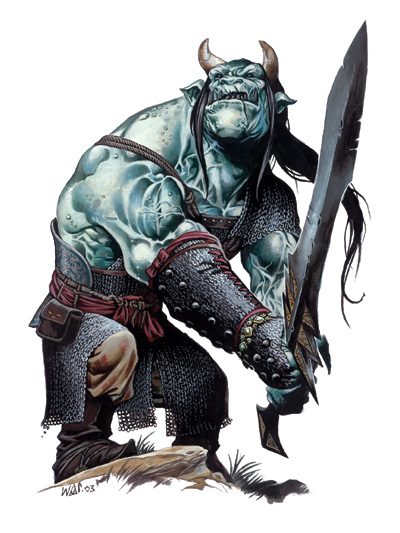
The ogre mage is a more intelligent and dangerous variety of its mundane cousin. Rapacious and cruel by nature, ogre mages often lead organized raids for slaves, treasure, and food.
These creatures dwell in fortified structures or underground lairs, usually living alone or with a small group of ogre followers. Status among ogre mages is measured by wealth. While they do not generally associate with their own kind, they often undertake raids and schemes in competition with one another to amass the most riches.
Ogre mages rely on their spell-like abilities, resorting to physical combat only when necessary. When faced with obviously superior forces, they prefer to retreat using gaseous form rather than fight a losing battle. Ogre mages hold deep, abiding grudges, however, and the unwise person who crosses one would do well to keep looking over one's shoulder.
An ogre mage stands about 10 feet tall and weighs up to 700 pounds. Its skin varies in color from light green to light blue, and its hair is black or very dark brown. Ogre mages favor loose, comfortable clothing and lightweight armor.
OGRE MAGE RACIAL TRAITS
-
+10 Strength, +6 Constitution, +4 Intelligence, +4 Wisdom, +6 Charisma.
-
Large size. -1 penalty to Armor Class, -1 penalty on attack rolls, -4 penalty on Hide checks, +4 bonus on grapple checks, lifting and carrying limits double those of Medium characters.
-
Space/Reach: 10 feet/10 feet.
-
An ogre mage's base land speed is 40 feet. It also has a fly speed of 40 feet (good).
-
Darkvision up to 60 feet and low-light vision.
-
Racial Hit Dice: An ogre mage begins with five levels of giant, which provide 5d8 Hit Dice, a base attack bonus of +3, and base saving throw bonuses of Fort +4, Ref +1, and Will +1.
-
Racial Skills: An ogre mage's giant levels give it skill points equal to 8 x (2 + Int modifier [minimum 1]). Its class skills are Concentration, Listen, Spellcraft, and Spot.
-
Racial Feats: An ogre mage's giant levels give it two feats.
-
+5 natural armor bonus.
-
Change Shape (Su): An ogre mage can assume the form of any Small, Medium, or Large humanoid or giant.
-
Spell-Like Abilities: Caster level 9th. The save DCs are Charisma-based.
At will - darkness, invisibility;
1/day - charm person cone of cold, gaseous form, sleep.
-
Flight (Su): An ogre mage can cease or resume flight as a free action. While using gaseous form it can fly at its normal speed and has perfect maneuverability.
-
Regeneration 5 (Ex): Fire and acid deal normal damage to an ogre mage. An ogre mage that loses a limb or body part can reattach it by holding the severed member to the stump. Reattachment takes 1 minute. If the head or some other vital organ is severed, it must be reattached within 10 minutes or the creature dies. An ogre mage cannot regrow lost body parts.
-
Spell resistance equal to 19 + class levels.
-
Automatic Languages: Common, Giant. Bonus Languages: Dwarven, Goblin, Infernal, Orc.
-
Favored Class: Sorcerer.
-
Level adjustment +7.
ORCS
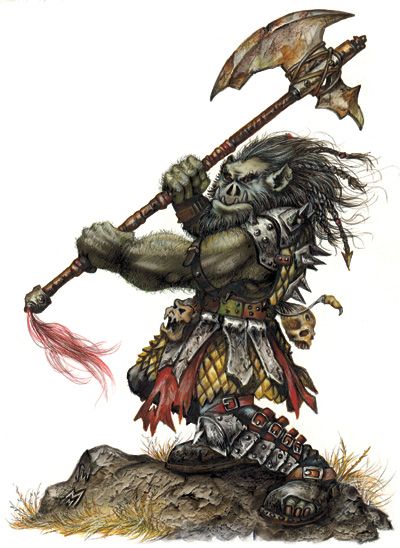
Orcs are aggressive humanoids that raid, pillage, and battle other creatures. They have a hatred of elves and dwarves that began generations ago, and often kill such creatures on sight.
An orc's hair usually is black. It has lupine ears and reddish eyes. Orcs prefer wearing vivid colors that many humans would consider unpleasant, such as blood red, mustard yellow, yellow-green, and deep purple. Their equipment is dirty and unkempt. An adult male orc is a little over 6 feet tall and weighs about 210 pounds. Females are slightly smaller.
When not actually fighting other creatures, orcs are usually planning raids or practicing their fighting skills. Orcs are proficient with all simple weapons, preferring those that cause the most damage in the least time. Many orcs who take up the warrior or fighter class also gain proficiency with the falchion or the greataxe as a martial weapon. They enjoy attacking from concealment and setting ambushes, and they obey the rules of war (such as honoring a truce) only as long as it is convenient for them.
Orcs believe that to survive, they must conquer as much territory as possible, which puts them at odds with all intelligent creatures that live near them. They are constantly warring with or preparing to war with other humanoids, including other orc tribes. They can ally with other humanoids for a time but quickly rebel if not commanded by orcs. Their deities teach them that all other beings are inferior and that all worldly goods rightfully belong to the orcs, having been stolen by the others. Orc spellcasters are ambitious, and rivalries between them and warrior leaders sometimes tear a tribe apart.
Orc society is patriarchal: Females are prized possessions at best and chattel at worst. Male orcs pride themselves on the number of females they own and male children they sire, as well as their battle prowess, wealth, and amount of territory. They wear their battle scars proudly and ritually scar themselves to mark significant achievements and turning points in their lives.
An orc lair may be a cave, a series of wooden huts, a fort, or even a large city built above and below ground. A tribe includes females (as many as there are males), young (half as many as there are females), and slaves (about one for every ten males).
The chief orc deity is Gruumsh, a one-eyed god who tolerates no sign of peaceability among his people. An orc cleric has access to two of the following domains: Chaos, Evil, Strength, or War (favored weapon: any spear).
ORC RACIAL TRAITS
-
+4 Strength, -2 Intelligence, -2 Wisdom, -2 Charisma.
-
Medium size.
-
An orc's base land speed is 30 feet.
-
Darkvision out to 60 feet.
-
Light Sensitivity: Orcs are dazzled in bright sunlight or within the radius of a daylight spell.
-
Automatic Languages: Common, Orc. Bonus Languages: Dwarven, Giant, Gnoll, Goblin, Undercommon.
-
Favored Class: Barbarian.
AASIMARS
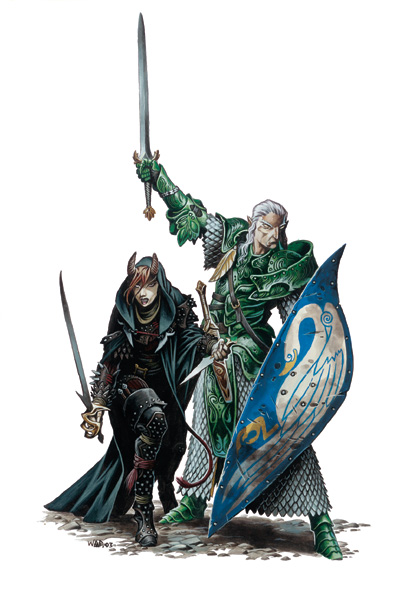
Planetouched is a general word to describe someone who can trace his or her bloodline back to an outsider, usually a fiend or celestial. The effects of having a supernatural being in one's heritage last for many generations. Although not as dramatically altered as a half-celestial or a half-fiend, planetouched still retain some special qualities.
Two planetouched varieties are the most common: Aasimars are humans with some trace of celestial blood in their veins, and tieflings have some fiendishness in their family tree.
Graced with a touch of the holy, aasimars are usually tall, good-looking, and generally pleasant. Some have a minor physical trait suggesting their heritage, such as silver hair, golden eyes, or an unnaturally intense stare.
Most aasimars are decidedly good-aligned. They fight against evil causes and attempt to sway others to do the right thing. Occasionally they take on the vengeful, judgmental aspect of their celestial ancestor, but this is rare. They are rarely found in leadership positions and often live as loners due to their absolute dedication to goodness. Others are less fanatical and fit seamlessly into normal human society.
Aasimars usually like a fair, straightforward contest. Against a particularly evil foe, however, they fight with utter conviction and to the death.
AASIMAR RACIAL TRAITS
-
+2 Wisdom, +2 Charisma.
-
Medium size.
-
An aasimar's base land speed is 30 feet.
-
Darkvision: Aasimars can see in the dark up to 60 feet.
-
Racial Skills: Aasimars have a +2 racial bonus on Spot and Listen checks.
-
Daylight (Sp): An aasimar can use daylight once per day as a 1st-level caster or a caster of his class levels, whichever is higher.
-
Resistance to acid 5, cold 5, and electricity 5.
-
Automatic Languages: Common, Celestial. Bonus Languages: Draconic, Dwarven, Elven, Gnome, Halfling,Sylvan.
-
Favored Class: Paladin.
-
Level adjustment +1.
TIEFLINGS
Twisted, devious, and untrustworthy, tieflings more often than not follow their inherent tendencies and heed the call to evil. A few defy their nature, but still must fight against popular opinion (if their nature is known) or the feeling of otherworldly "wrongness" that seems to follow them wherever they go.
Aside from a demeanor that many find disturbing, many tieflings are indistinguishable from humans. Others have small horns, pointed teeth, red eyes, a whiff of brimstone about them, or even cloven feet. No two tieflings are the same.
In most human societies, tieflings maintain a low profile, operating as thieves, assassins, or spies. Occasionally one rises to a position of power, but when its nature is revealed it quickly becomes an outcast.
Tieflings are sneaky, subtle, and generally conniving. They prefer to strike from ambush and usually avoid a fair fight if they can.
TIEFLING RACIAL TRAITS
-
+2 Dexterity, +2 Intelligence, -2 Charisma.
-
Medium size.
-
A tiefling's base land speed is 30 feet.
-
Darkvision out to 60 feet.
-
Racial Skills: Tieflings have a +2 racial bonus on Bluff and Hide checks.
-
Darkness (Sp): A tiefling can use darkness once per day (caster level equal to class levels).
-
Resistance to cold 5, electricity 5, and fire 5.
-
Automatic Languages: Common, Infernal. Bonus Languages: Draconic, Dwarven, Elven, Gnome, Goblin, Halfling, Orc.
-
Favored Class: Rogue.
-
Level adjustment +1.
RAKSHASAS
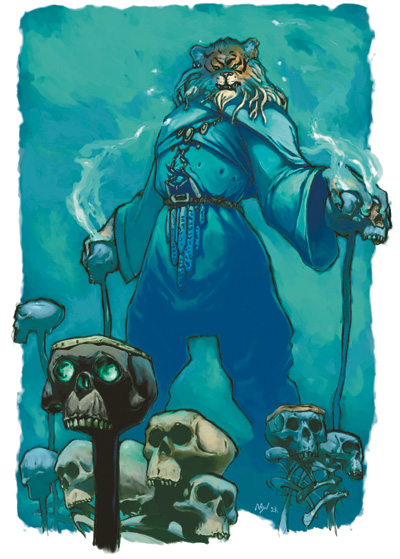
Some say rakshasas are the very embodiment of evil. Few beings are more malevolent.
A closer look at a rakshasa reveals that the palms of its hands are where the backs of the hands would be on a human. While this doesn't detract from the creature's manual dexterity, it makes a rakshasa look very disturbing to those unfamiliar with the creature.
In close combat, which a rakshasa disdains as ignoble, it employs its sharp claws and powerful bite. Whenever possible, it uses its other abilities to make such encounters unnecessary.
RAKSHASA RACIAL TRAITS
-
+2 Strength, +4 Dexterity, +6 Constitution, +2 Intelligence, +2 Wisdom, +6 Charisma.
-
Medium size.
-
A rakshasa's base land speed is 40 feet.
-
Darkvision out to 60 feet.
-
Racial Hit Dice: A rakshasa begins with seven levels of outsider, which provide 7d8 Hit Dice, a base attack bonus of +7, and base saving throw bonuses of Fort +5, Ref +5, and Will +5.
-
Racial Skills: A rakshasa's outsider levels give it skill points equal to 10 x (8 + Int modifier). Its class skills are Bluff, Disguise, Listen, Move Silently, Perform, Sense Motive, and Spot. A rakshasa has a +4 racial bonus on Bluff and Disguise checks, and it can gain further bonuses by using change shape (+10 on Disguise checks) and detect thoughts (+4 on Bluff and Disguise checks).
-
Racial Feats: A rakshasa's outsider levels give it three feats.
-
+9 natural armor bonus.
-
Natural Weapons: Bite (1d6) and 2 claws (1d4).
-
Detect Thoughts (Su): A rakshasa can continuously use detect thoughts as the spell (caster level 18th; Will save negates, DC is 13 + the character's Cha modifier). It can suppress or resume this ability as a free action. The save DC is Charisma-based.
-
Spells: A rakshasa character casts spells as a 7th-level sorcerer. If the character takes additional levels of sorcerer, these levels stack with the rakshasa's base spellcasting ability for spells known, spells per day, and other effects dependent on caster level. A rakshasa character likewise uses the sum of its racial spellcasting levels and class levels to determine the abilities of its familiar.
-
Change Shape (Su): A rakshasa can assume any humanoid form, or revert to its own form, as a standard action. In humanoid form, a rakshasa loses its claw and bite attacks (although it often equips itself with weapons and armor instead). A rakshasa remains in one form until it chooses to assume a new one. A change in form cannot be dispelled, but the rakshasa reverts to its natural form when killed. A true seeing spell reveals its natural form.
-
Damage reduction 15/good and piercing.
-
Spell resistance equal to 27 + class levels.
-
Automatic Languages: Common, Infernal. Bonus Languages: Sylvan, Undercommon.
-
Favored Class: Sorcerer.
-
Level adjustment +7.
SATYRS
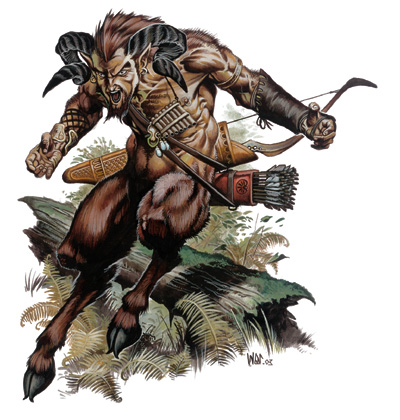
Satyrs, also known as fauns, are hedonistic creatures that frolic in the wild places of the world. They love fine food, strong drink, and passionate romance.
A satyr's hair is red or chestnut brown, while its hooves and horns are jet black.
A satyr is far more likely to be carrying musical instruments or bottles of wine than weapons. For the most part, satyrs leave travelers alone. They are, however, more than a little mischievous and often seek fun at the expense of those who wander too near their woodland homes.
The keen senses of a satyr make it almost impossible to surprise one in the wild. Conversely, with their own natural grace and agility, satyrs can sneak up on travelers who are not carefully watching the surrounding wilderness.
Once engaged in battle, an unarmed satyr attacks with a powerful head butt. A satyr expecting trouble is likely to be armed with a bow and a dagger and typically looses arrows from hiding, weakening an enemy before closing. A satyr often uses its pipes to charm and seduce especially comely women or to put a party of adventurers to sleep and then steal their valuables.
SATYR RACIAL TRAITS
-
+2 Dexterity, +2 Constitution, +2 Intelligence, +2 Wisdom, +2 Charisma.
-
Medium size.
-
A satyr's base land speed is 40 feet.
-
Low-light vision.
-
Racial Hit Dice: A satyr begins with five levels of fey, which provide 5d8 Hit Dice, a base attack bonus of +2, and base saving throw bonuses of Fort +1, Ref +4, and Will +4.
-
Racial Skills: A satyr's fey levels give it skill points equal to 8 x (6 + Int modifier). Its class skills are Bluff, Hide, Knowledge (nature), Listen, Move Silently, Perform, and Spot. Satyrs have a +4 racial bonus on Hide, Listen, Move Silently, Perform, and Spot checks.
-
Racial Feats: A satyr's fey levels give it two feats. A satyr receives Alertness as a bonus feat.
-
+4 natural armor bonus.
-
Natural Weapons: Head butt (1d6).
-
Pipes (Su): Satyrs can play a variety of magical tunes on their pan pipes. Usually, only one satyr in a group carries pipes. When it plays, all creatures within a 60-foot spread (except satyrs) must succeed on a Will save or be affected by charm person, sleep, or fear (caster level 10th; the satyr chooses the tune and its effect). In the hands of other beings, these pipes have no special powers. A creature that successfully saves against any of the pipe's effects cannot be affected by the same set of pipes for 24 hours. The save DC is Charisma-based.
-
Damage reduction 5/cold iron.
-
Automatic Languages: Sylvan. Bonus Languages: Common, Elven, Gnome.
-
Favored Class: Bard.
-
Level adjustment +2.
PIXIES
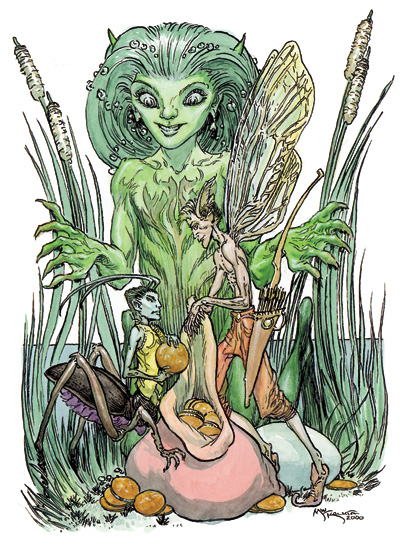
Pixies are merry pranksters that love to lead travelers astray. They can, however, be roused to surprising ire when dealing with evil creatures.
These sprites love to trick misers out of their wealth. They do not covet treasure themselves but use it to taunt and frustrate greedy folk. If a victim of pixie pranks exhibits no greed or demonstrates a good sense of humor, the tricksters may allow the individual to choose a reward from their hoard.
Pixies wear bright clothing, often including a cap and shoes with curled and pointed toes.
The normally carefree pixies ferociously attack evil creatures and unwanted intruders. They take full advantage of their invisibility and other abilities to harass and drive away opponents.
PIXIE RACIAL TRAITS
-
-4 Strength, +8 Dexterity, +6 Intelligence, +4 Wisdom, +6 Charisma.
-
Small size. +1 bonus to Armor Class, +1 bonus on attack rolls, +4 bonus on Hide checks, -4 penalty on grapple checks, lifting and carrying limits 3/4 those of Medium characters.
-
A pixie's base land speed is 20 feet. It also has a fly speed of 60 feet (good).
-
Low-light vision.
-
Racial Skills: Pixies have a +2 racial bonus on Listen, Search, and Spot checks.
-
Racial Feats: A pixie receives Dodge and Weapon Finesse as bonus feats.
-
+1 natural armor bonus.
-
Spell-Like Abilities: Caster level 8th. The save DCs are Charisma-based.
1/day - lesser confusion, dancing lights, detect chaos, detect good, detect evil, detect law, detect thoughts, dispel magic, entangle, permanent image (visual and auditory elements only)
One pixie in ten can use Otto's irresistible dance (caster level 8th) once per day.
-
Greater Invisibility (Su): A pixie remains invisible even when it attacks. This ability is constant, but the pixie can suppress or resume it as a free action.
-
Damage reduction 10/cold iron.
-
Spell resistance equal to 15 + class levels.
-
Automatic Languages: Common, Sylvan. Bonus Languages: Elven, Gnome, Halfling.
-
Favored Class: Sorcerer.
-
Level adjustment +4 (+6 if the pixie can use Otto's irresistible dance).
TROGLODYTES
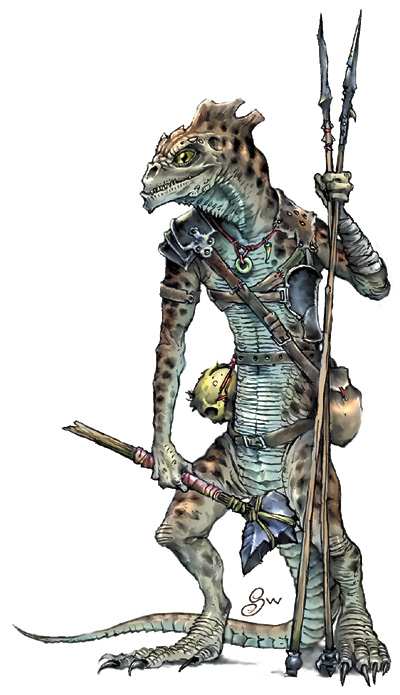
Troglodytes are revolting lizard creatures as evil as the foulest of demons. They are very warlike and savor the taste of their enemies - especially humanoids.
Troglodytes are not especially intelligent, but their ferocity and natural cunning more than compensate for this deficiency. They often launch bloody raids against humanoid settlements or ambush caravans in warm climates. They guard their lairs aggressively, lashing out at anyone who comes too near.
Troglodyte tribes are ruled by the largest and fiercest among them, with subchieftains who have distinguished themselves in battle. Trogs like to lair near humanoid settlements to prey on inhabitants and their livestock. They raid on moonless nights when their darkvision and coloration are most effective.
Troglodytes prize steel above all else. Though individuals usually have no wealth, a lair may contain valuable items casually discarded, pushed into corners, or mixed in with refuse. The lair is usually a large cave with smaller caves for the hatchlings and eggs. A lair has hatchlings equal to one-fifth the number of adults and eggs equal to one-tenth.
Troglodytes revere Laogzed, a vile deity who resembles a cross between a toad and a lizard.
TROGLODYTE RACIAL TRAITS
-
-2 Dexterity, +4 Constitution, -2 Intelligence.
-
Medium size.
-
A troglodyte's base land speed is 30 feet.
-
Darkvision out to 90 feet.
-
Racial Hit Dice: A troglodyte begins with two levels of humanoid, which provide 2d8 Hit Dice, a base attack bonus of +1, and base saving throw bonuses of Fort +3, Ref +0, and Will +0.
-
Racial Skills: A troglodyte's humanoid levels give it skill points equal to 5 x (2 + Int modifier, minimum 1). Its class skills are Hide and Listen. The skin of a troglodyte changes color somewhat, allowing it to blend in with its surroundings like a chameleon and providing a +4 racial bonus on Hide checks (+8 in rocky or underground surroundings).
-
Racial Feats: A troglodyte's humanoid levels give it one feat. A troglodyte receives Multiattack as a bonus feat.
-
+6 natural armor bonus.
-
Natural Weapons: 2 claws (1d4) and bite (1d4).
-
Stench (Ex): When a troglodyte is angry or frightened, it secretes an oily, musk-like chemical that nearly every form of animal life finds offensive. All living creatures (except troglodytes) within 30 feet of a troglodyte must succeed on a DC 13 Fortitude save or be sickened for 10 rounds. The save DC is Constitution-based. Creatures that successfully save cannot be affected by the same troglodyte's stench for 24 hours. A delay poison or neutralize poison spell removes the effect from the sickened creature. Creatures with immunity to poison are unaffected, and creatures resistant to poison receive their normal bonus on their saving throws.
-
Automatic Languages: Draconic. Bonus Languages: Common, Giant, Goblin, Orc.
-
Favored Class: Cleric.
-
Level adjustment +2.
TROLLS
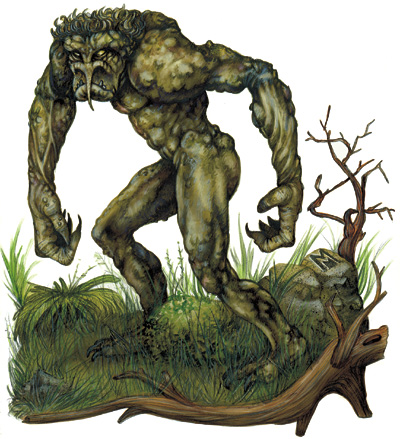
Trolls are horrid carnivores found in all climes, from arctic wastelands to tropical jungles. Most creatures avoid these beasts, who know no fear and attack unceasingly when hungry.
Trolls have ravenous appetites, devouring everything from grubs to bears and humanoids. They often lair near settlements and hunt the inhabitants until they devour every last one.
Trolls walk upright but hunched forward with sagging shoulders. Their gait is uneven, and when they run, their arms dangle and drag along the ground. For all this seeming awkwardness, trolls are very agile.
Trolls have no fear of death: They launch themselves into combat without hesitation, flailing wildly at the closest opponent. Even when confronted with fire, they try to get around the flames and attack.
A typical adult troll stands 9 feet tall and weighs 500 pounds. Females are slightly larger than males. A troll's rubbery hide is moss green, mottled green and gray, or putrid gray. The hair is usually greenish black or iron gray.
TROLL RACIAL TRAITS
-
+12 Strength, +4 Dexterity, +12 Constitution, -4 Intelligence (minimum 3), -2 Wisdom, -4 Charisma.
-
Large size. -1 penalty to Armor Class, -1 penalty on attack rolls, -4 penalty on Hide checks, +4 bonus on grapple checks, lifting and carrying limits double those of Medium characters.
-
Space/Reach: 10 feet/10 feet.
-
A troll's base land speed is 30 feet.
-
Darkvision out to 60 feet and low-light vision.
-
Racial Hit Dice: A troll begins with six levels of giant, which provide 6d8 Hit Dice, a base attack bonus of +4, and base saving throw bonuses of Fort +5, Ref +2, and Will +2.
-
Racial Skills: A troll's giant levels give it skill points equal to 9 x (2 + Int modifier, minimum 1). Its class skills are Listen and Spot.
-
Racial Feats: A troll's giant levels give it three feats.
-
+5 natural armor bonus.
-
Natural Weapons: 2 claws (1d6) and bite (1d6).
-
Rend (Ex): If a troll hits with both claw attacks, it latches onto the opponent's body and tears the flesh. This attack automatically deals an additional 2d6 + 1-1/2 times Str modifier points of damage.
-
Regeneration 5 (Ex): Fire and acid deal normal damage to a troll. If a troll loses a limb or body part, the lost portion regrows in 3d6 minutes. The creature can reattach the severed member instantly by holding it to the stump.
-
Automatic Languages: Giant. Bonus Languages: Common, Orc.
-
Favored Class: Fighter.
-
Level adjustment +5.
YUAN-TI PUREBLOODS
Yuan-ti purebloods appear human at first glance, with only very subtle snakelike features.
Purebloods are the least intelligent of the yuan-ti, though they still pride themselves on being more intelligent than humans. Purebloods often disguise themselves as humans and work among them as spies for their abomination masters.
YUAN-TI PUREBLOOD RACIAL TRAITS
-
+2 Dexterity, +2 Intelligence, +2 Charisma.
-
Medium size.
-
A yuan-ti pureblood's base land speed is 30 feet.
-
Darkvision out to 60 feet.
-
Racial Hit Dice: A yuan-ti pureblood begins with four levels of monstrous humanoid, which provide 4d8 Hit Dice, a base attack bonus of +4, and base saving throw bonuses of Fort +1, Ref +4, and Will +4.
-
Racial Skills: A yuan-ti pureblood's monstrous humanoid levels give it skill points equal to 7 × (2 + Int modifier). Its class skills are Concentration, Disguise, Hide, Knowledge (any), Listen and Spot.
-
Racial Feats: A yuan-ti pureblood's monstrous humanoid levels give it two feats. Yuan-ti purebloods receive Alertness and Blind-Fight as bonus feats.
-
+1 natural armor bonus.
-
Spell-Like Abilities: Caster level 4th. The save DCs are Charisma-based.
1/day - animal trance, cause fear, charm person, darkness, entangle.
-
Alternate Form (Sp): All yuan-ti can assume the form of a Tiny to Large viper (see the Snake entry, page 280) as a psionic ability. This ability is similar to a polymorph spell (caster level 19th), but a yuan-ti does not regain any hit points for changing form, and it can only assume viper forms. The yuan-ti loses its natural weapons (if any) and gains the natural weapon of the viper form it assumes. If the yuan-ti has a poisonous bite of its own, it uses its own or the viper's poison, whichever is more potent.
-
Detect Poison (Sp): All yuan-ti have the psionic ability to detect poison as the spell (caster level 6th).
-
Spell resistance equal to class levels + 14.
-
Automatic Languages: Yuan-ti, Common. Bonus Languages: Abyssal, Draconic.
-
Favored Class: Ranger.
-
Level adjustment +2.